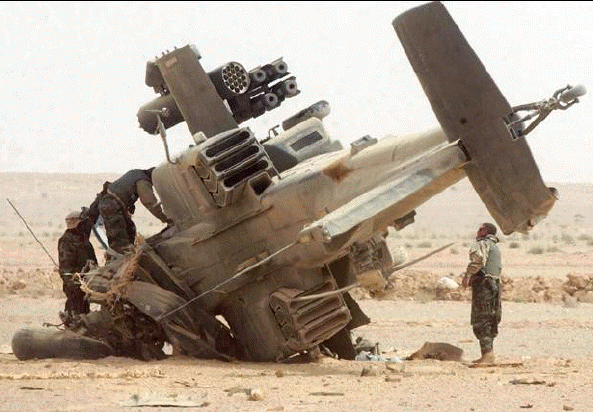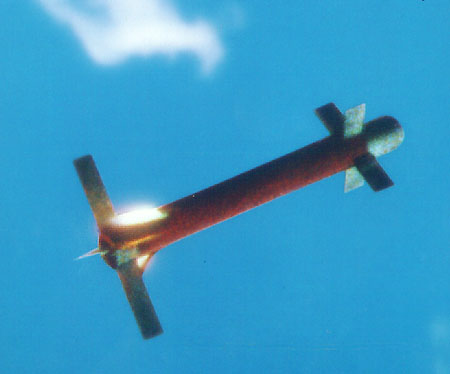The EFOGM is the most revolutionary weapon of the past three decades. Unfortunately, few US military officers are aware of its existence. The EFOGM (below) is basically a long-range TOW anti-tank guided missile perfected by the US Army in the 1990s. It flies a flat trajectory guided by a TV camera in the nose of the missile that remains connected to the launcher by spooling out fiber optic cable thinner than a fishing line. A soldier watching a video screen guides the missile with a joystick and crashes it into the target. It can strike armored vehicles, helicopters, or any tactical target within 10 miles. More details are here: EFOGM
A tank battalion can be annihilated by an EFOGM battery several miles away, especially since an EFOGM strikes downward into a tank's light overhead armor. Even attack helicopters will stay clear of areas where EFOGMs are reported, since EFOGMs can be used against them. Since an EFOGM does not fly a ballistic path, its launch location cannot be determined by counterbattery radar. EFOGMs do not need to "shoot and move" they can "shoot and shoot." As a result, EFOGMs teamed with counterbattery radar can devastate gun batteries and mortar positions from ten miles away.

EFOGMs may be fired into an area simply so that its TV camera can verify an enemy presence for gun batteries. EFOGMs can also be fired from HMMWVs in landing craft cruising a few miles offshore. The Navy, which has long range wire-guided torpedoes in service, can also fire these wire-guided missiles from helicopters, ships, or patrol boats to hit small boats and targets ashore. The EFOGM is an ideal weapon for light forces. Two can fit inside a C-130 and a C-17 can carry eight. An EFOGM system mounted aboard a HMMWV requires only 40% of the manpower, 10% of the ammunition, and 25% of the embark space of a 10,000 pound 155mm howitzer towed by a 22,000 pound truck. Here are comments by retired Army officer Mark Gallmeier's about the history of the FOGM, which is now called the Enhanced FOGM, or EFOGM:
"Since I was involved in this, I can give you a bit of background on why the US Army didn't take FOGM in the late 70s. It was a correct decision back then, given that the Army was designing to fight and win at 1-3 reverse odds. The whole concept of modifying the AGM-65 (Army Ground Missile 65) TOW (Tube Launched Optically Tracked Wire Command Link Guided Missile) missile with fibre optic cable and a tv-seeker warhead was an Army MICOM (Missile Command) engineer's idea dating from 1975. The U.S. Army in fact invented the concept of FOGM. As an exercise in low-cost creative thinking, it was brilliant. Here's why Hellfire was chosen over FOGM in the 1970s.
a. Hellfire had a designed range of 18 kilometers, compared to FOGM's then and still current 10km. Since the Hellfire range was classified (public references only said "in excess of 3750 meters") outsiders were confused. They didn't know it was going to be 5 TIMES in excess. This range of course put the AH-64 well outside the current and 20 year projected Soviet SHORAD (Short Range Air Defense) umbrella. You know the 'upsided down wedding cake' model for ADA (Air Defense Artillery) coverage.
b. Hellfire, as a LOS laser designated weapon had a guidance package about the same price as the FOGM TV (television) package promised. But FOGM has to carry all its optics with it, and they're destroyed with each round. Apache carried all the computers, thermal sights (very expensive and still large back in the 1970s), IR etc with it in its TAADS package (Target Acquisition And Designation System). FOG-M therefore would only be a daylight VFR (Visual Flight Rules) weapon with about 60% of Hellfire's range. FOGM accuracy didn't promise to be nearly as good, either. The TAADS is stabilized in 3 axes. In the 1970s the computer technology simply wasn't available to enhance the returned FOGM picture back and stabilize it. TV guided bombs are released at targets known to exist and whose location is well fixed. FOG-M has to acquire during its cruise, and the cruise time is limited.
The vast advances in computer technology since the 1970s have resolved most of this problem, of course. Advances in optics technology have improved the raw picture, reduced the seeker package price and increased the night/low visibility capabilities.
c. FOGM is an indirect fire weapon and therefore ground mounted. The shorter range FOGM package rolling on wheels simply wouldn't give division and corps commanders the capability to RAPIDLY mass decisive anti-tank fires at the critical point, at least not like the AH-64 (Attack Helicopter 64) Apache. The whole AH-64 organization stays outside the range of enemy artillery. Apache rearms/refuels outside enemy artillery and quickly shuttles in. Although we pushed AH-64 battalions down to division, this organization was subject to detachment by the Corps commander at a moment's notice. With two divisions' AH-64 battalions, plus three more at Corps level, the Corps commander had the theoretical capability to mass 5 x 18 = 90 Apaches x 16 Hellfires = 1,440 Hellfires at a threatened breakthrough.
Casualties and serviceability rates would reduce this optimal number, but there in nutshell is how Generals Meyer & Starry planned to DESTROY (not 'attrit', 'delay', or 'stop') an invading Warsaw Pact force. FOGM then and even now doesn't promise that kind of battlefield decisiveness. General Meyer was not kidding when he told Congress in 1980 that if they cancelled the Apache he would have to redesign the entire US Army.
 There was never any chance of massing shorter
range, less accurate FOGMs on wheels that way. Apache could redeploy in
30 minutes. FOGM might make it in half a day, depending on the condition of
the lateral road network. The deeper FOGM wants to penetrate, the
closer it has to come to the enemy's forward elements, meaning it becomes
vulnerable to artillery, unless you put it inside a track.
There was never any chance of massing shorter
range, less accurate FOGMs on wheels that way. Apache could redeploy in
30 minutes. FOGM might make it in half a day, depending on the condition of
the lateral road network. The deeper FOGM wants to penetrate, the
closer it has to come to the enemy's forward elements, meaning it becomes
vulnerable to artillery, unless you put it inside a track.
d. Threat analysis revealed that there was one significant threat to the AH-64 before 2000: You wrote: "Even attack helicopters would stay clear of areas where EFOG-Ms were reported, since EFOGMs can be used against them."
We realized that in 1977. And when that datum fell out of analysis, it was the end of FOGM for that generation. General E.C. "Shy" Meyer, then Chief of Staff, crushed the FOGM boomlet personally. Why should we do the Soviet's development for them? It took the GRU (Soviet Military Intelligence) almost no time to get the blueprints for most of the AH-64 itself. Only way to keep them from getting FOGM was to not build it, even as an R&D (Research and Development) project. I was told Meyer had said he would personally end the career of anyone, military or civil service, who spent one more penny or said one more word about FOGM. It was another example of the aluminum strip 'window' radar jamming story from World War II. Discussion, comment and criticism continued in thinking circles outside. But it was impossible for anyone in possession of the facts to educate the well meaning outsiders without educating the non-well meaning Soviets, too.
e. FOGM is still not much of a threat since the Hellfire ranges have gone up and now the Longbow Apache has appeared. The reason the Army may buy FOGM is mostly for its anti-helicopter potential. Gunships still have to close in to use guns or dumb rockets. FOGM remains a second best weapon compared to Hellfire for anti-tank or other hi-value ground targets. The problems of rapid lateral massing also still remain.
The place where we're really missing out is SMALLER FOGM's for the infantry. The trick that was done with the TOW could also be done with a much smaller rocket about the size of the old M-72A2 LAW (Light Anti-Tank Weapon). Small FOGMs will displace mortars from the TOE (Table of Organization and Equipment). Cheap rockets with cameras, fibre optic cables and parachutes will be an excellent tactical intelligence tool for light infantry companies and platoons. A computer mounted on a track, HMMWV (High Mobility Multipurpose Wheeled Vehicle) or even an ATV (All Terrain Vehicle) could rapidly process the imagery, giving platoon thru battalion commanders real time on-call aerial reconnaissance and first cut imagery analysis."
I agree that Hellfires fired from an Apache is a superior weapon. However, Apaches may not be present in expeditionary operations for several weeks. In addition, an Apache is not always "on station" for immediate support, while an EFOGM can sit in a HMMWV with frontline units. Finally, EFOGMs teamed with counterbattery radar is a deadly combination that can respond to enemy artillery and mortar fire within seconds. This book includes a proposal for a smaller EFOGM system, Video-Guided Missile (VIGUMS). A ground-fired Hellfire is also a great weapon, but it requires someone to lase the target and fairly clear weather, whereas the EFOGM can be fired at reported areas of enemy activity and confirm and destroy targets, even at night or in bad weather with its infrared camera.
 When Cold war procurement was cut, none of the US Army's tank, infantry, air defense, or artillery communities adopted the
EFOGM; each favored improving their traditional systems. Despite its revolutionary capability,
plans to field the EFOGM were dropped in 1999 after successful tests by the 82d Airborne
Division. After the Cold War ended, the US Army never fielded the EFOGMs. Mark Gallmeier
noted that Army Generals recognized this simple weapon can devastate
their expensive and sophisticated attack helicopters and tanks, so maybe that is
why it was killed. If the US
Army fielded the EFOGM, other nations will build versions that can stop the
US Army war machine.
When Cold war procurement was cut, none of the US Army's tank, infantry, air defense, or artillery communities adopted the
EFOGM; each favored improving their traditional systems. Despite its revolutionary capability,
plans to field the EFOGM were dropped in 1999 after successful tests by the 82d Airborne
Division. After the Cold War ended, the US Army never fielded the EFOGMs. Mark Gallmeier
noted that Army Generals recognized this simple weapon can devastate
their expensive and sophisticated attack helicopters and tanks, so maybe that is
why it was killed. If the US
Army fielded the EFOGM, other nations will build versions that can stop the
US Army war machine.
However, the Europeans have already developed the Polyphem fiber optic missile, with an incredible range of 60km by using a turbojet engine. Meanwhile, the Brazilians now have FOGMs in production and for sale. Their Avibras FOG-MPM (pictured) is a missile for multiple employment purposes, particularly against combat vehicles and fortifications. It has a modern guidance system based on data transmission by fiber-optic cable, offering operational efficiency even under severe battlefield conditions. Even South Korea has developed and fielded a video-guided fiber optic missile. While the United States devotes billions of dollars to make incremental improvements in traditional systems, other nations have jumped ahead.
©2015 www.G2mil.com